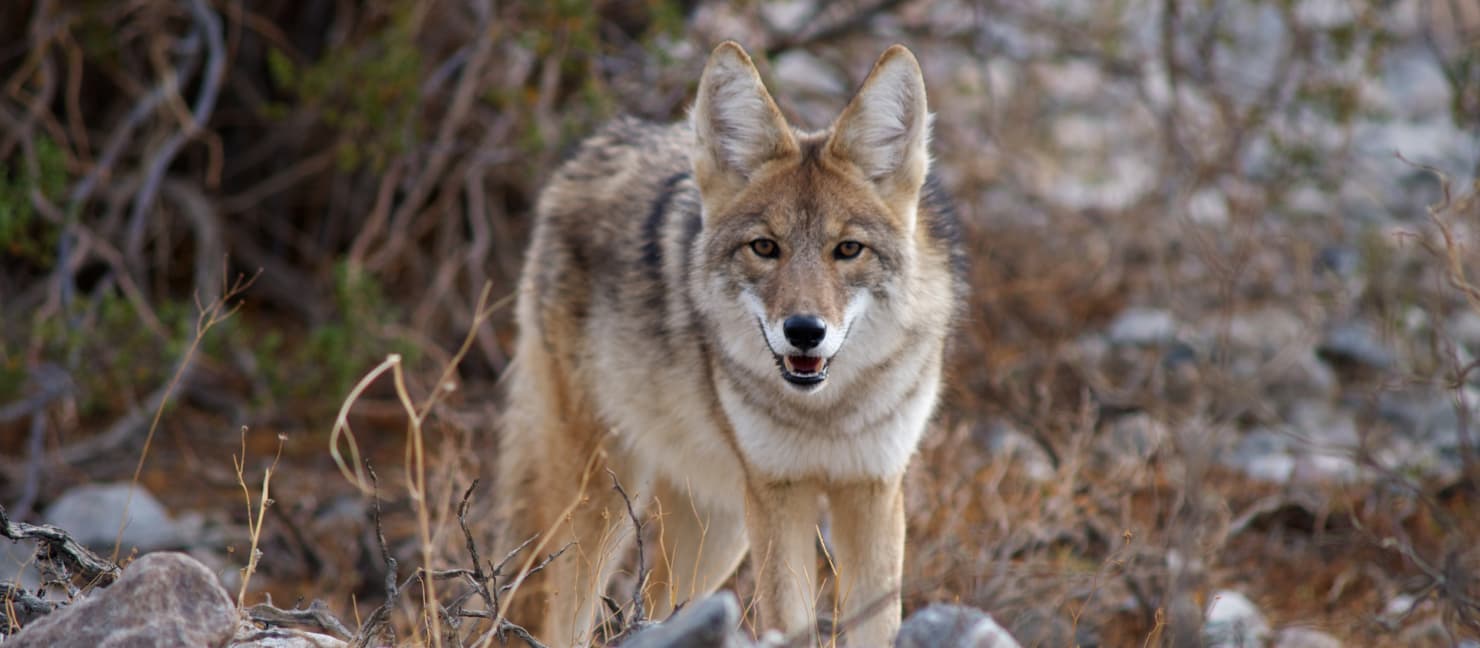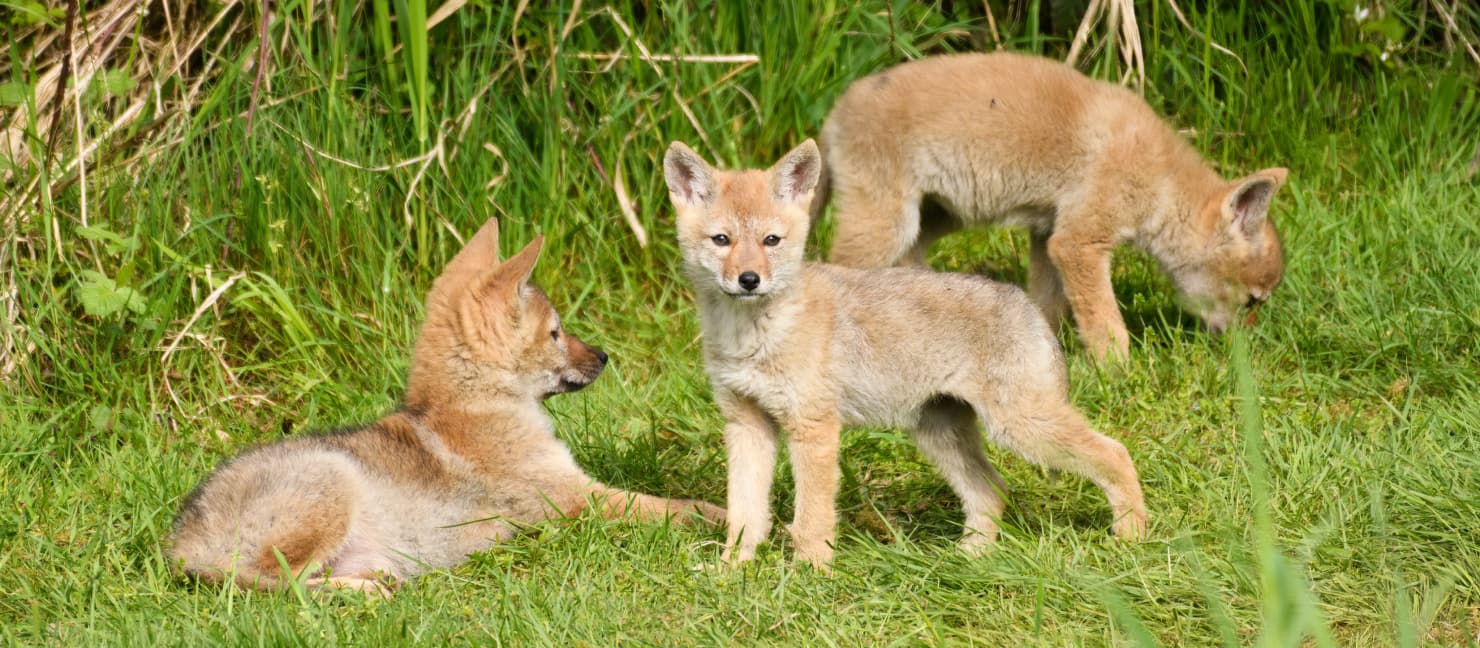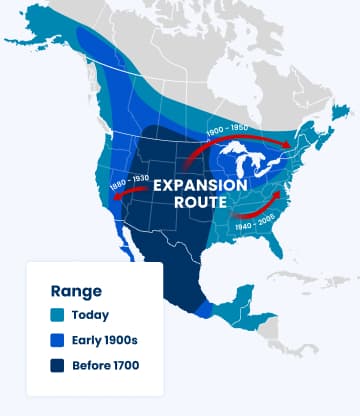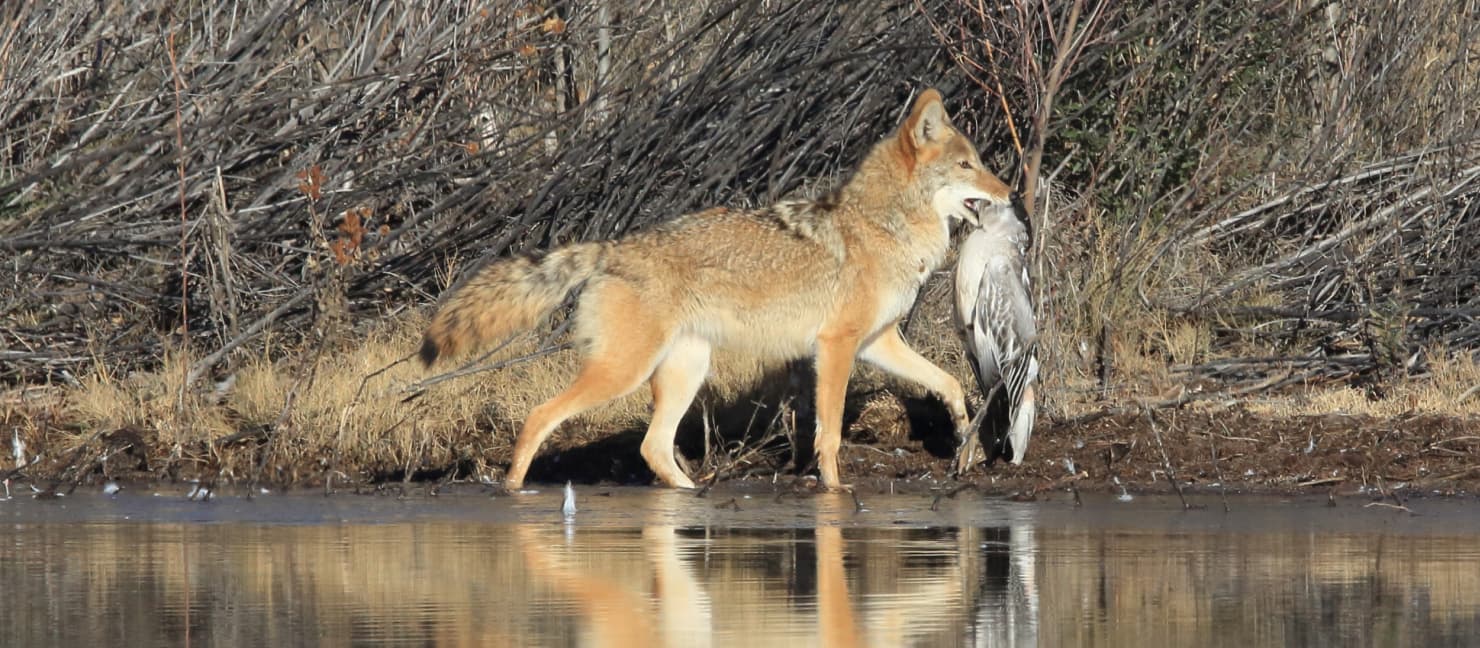How to Hunt Coyotes: Beginner Tips, Tactics + Tools

Chasing after the elusive coyote? Much like deer hunting, coyote hunts are a game of strategy and patience. They’re known varmints that can routinely cause a ruckus to deer and small game populations when theirs is left unchecked. So how do you hunt these song dogs? Dive into this guide to learn all about the best coyote hunting tips, the essential gear you need, and some important insights into their cunning behavior.
Key Takeaways
- Find out how to hunt coyotes by choosing the right location, scouting techniques, and so much more.
- From protecting livestock to reaping the benefits of their valuable fur, learn why you should be hunting coyotes.
- Interested in understanding coyote territory behavior? Grasp their habits and patterns to improve your hunting strategy and success rate.
- Discover what to wear coyote hunting, and understand the essentials of camouflage, layering, and scent control.
- Delve into the must-have tools and coyote hunting gear that will give you an edge in your endeavors.
How to Hunt Coyotes
Coyote hunting requires extensive preparation. Always consult local regulations to stay compliant with the law. Pay close attention to any necessary licenses and documentation you’ll need ahead of time. Finally, familiarize yourself with the specific times and days permitted for hunting.
Expert Tip:
While coyote hunting is legal year-round in most states, requirements and bounties vary from state-to-state. Some may not have bounties at all.
Where to Find Coyotes to Hunt
Choosing the right spot is crucial for a successful coyote hunt. Your location can make or break your overall hunting experience.
Hide Your Vehicle: If you drive to your hunting spot, conceal your vehicle well. Visible cars can alert and scare off coyotes.
Keep Your Distance from Dens: Avoid getting too close to coyote dens or the animals themselves. Their keen sense of smell and hearing can detect intruders from a distance.
Stay Low & Blend In: Instead of standing tall and making yourself noticeable, remain low. Use brush for cover and ensure you blend seamlessly into your environment.

When Is the Best Time for Coyote Hunting?
While in most states you can hunt them all year long, most coyote hunters prefer the fall and winter months. The winter is when their fur is at its thickest, and their prey options get increasingly restrictive. Because of this, they’re often much more active during the day.Timing is everything when it comes to coyote hunting. To maximize your chances and make the most of your hunting trip, consider the following tips:
Opt for Dawn or Dusk: Early mornings and evenings are prime times for hunting coyotes. These are their most active periods.
Avoid Midday Hunts: Coyotes typically rest and seek shade during the heat of the day, making afternoon hunts less successful.
Be Mindful of Their Habits: Remember, your success rate might dip during the middle of the day when coyotes are less active. Adjust your hunting schedule accordingly as you learn more about their habits + behaviors.
Seasonal Considerations for a Coyote Hunt
Understanding the seasonal behaviors of coyotes can significantly increase your success. Keep these key points in mind as you plan your hunts:
Breeding Season: Spanning from December to March, a coyote’s activity increases during this time. Be aware of their mating patterns during these months.
Post-Birth Movements: Once the pups are born, expect the pack to relocate from their den. This movement will influence your hunting strategy.
Prime Pelt Period: If you're hunting for thicker pelts, winter is your best bet! Coyotes boast their thickest and most luxurious coats during the winter.

Coyote Scouting Techniques
Since the 1950s, coyotes have expanded their range closer and closer (sometimes even inside) metropolitan areas. This geographic area has actually increased by as much as 40% since then. Over the years, they’ve overgrown many of their competitors (like wolves, cougars, etc.) populations. They have much less competition when hunting prey these days. So to help you better find them, here are some scouting techniques you should consider:
Food Source Areas: Prioritize areas abundant in coyote food sources like mice, birds, vermin, and near cattle farms. Seek permission from landowners if you want to hunt on private property.
Water Sources: Coyotes frequent areas with marshes, swamps, and creeks. These spots can be prime locations for spotting them.
Den Discovery: Finding a den and spotting fresh tracks can give you a significant advantage. It indicates recent coyote activity in the area.
Summer Scouting: The warmer months are ideal for scouting farms and open fields, since coyotes tend to roam these areas in search of food.

Expert Tip:
Scout for coyotes during the day. Focus on dens or areas with livestock close by. If a location seems promising, visit it at night. Use a coyote call, and wait for a response. If you hear howls, you've found a great spot to hunt coyotes!
Play the Wind While Coyote Hunting
Using the wind to your advantage can make or break your success. Here's how to ensure the wind works for you:
Face the Wind: When using a call, position yourself so the wind blows directly into your face. This helps mask your scent from approaching coyotes.
Anticipate Movements: Coyotes often circle downwind of distress calls, trying to catch a scent. Be prepared for this behavior.
Stay Stealthy: Remain still and silent. You’ll minimize the risk that a coyote will detect you. Remember: coyotes have impressive hearing and eyesight.
Back Protection: Having a fence or treeline at your back can prevent coyotes from going unnoticed. Alternatively, team up with a hunting buddy to watch your back — ensuring a 360-degree field of vision.

Switch Up Your Hunting Location
Variety is the spice of life, and it's no different in coyote hunting! Regularly changing your hunting location can significantly increase your success rate. Here's how:
Avoid Repetition: Refrain from hunting the same spot multiple times too frequently. It keeps the coyotes from becoming too familiar with your presence.
Limit Frequency: Even if you have a favorite spot, hunt there only once a week at most. Over-hunting an area can make coyotes wary.
Vary Your Calls: If you're hunting on the same property, consider alternating the calls you use. Different sounds can pique the interest of coyotes that have become accustomed to a particular call.
Why Do People Hunt Coyotes?
Coyotes are cunning and elusive creatures. People hunt them because they pose various challenges to the environment and other animals. Here's why considering them can be both beneficial and necessary:
Risk to Wild Game: Coyotes have a notorious appetite for whitetail fawns and elk calves. This predatory behavior spikes during spring, coinciding with the birth of their pups. As a result, wild game populations become especially vulnerable.
Predator Management: With limited natural predators, coyotes often turn their attention to livestock. This is particularly true during the harsh winter months when other food sources are scarce. This poses a significant threat to farmers and their livelihoods.
Pelts: Hunting coyotes isn't just about management; there's potential profit, too. Pelts in prime condition can fetch a good price in the market. Additionally, these pelts hold value for trading — offering hunters an avenue for bartering.
Disease Management: Coyotes can be carriers of various diseases, including canine hepatitis and rabies. Moreover, they often harbor parasites and ticks. Their susceptibility to flesh-eating mange makes them a potential health risk to other animals and even humans.

Common Coyote Territorial Behaviors
Coyotes roam the wild with these three common territorial behavior patterns: resident, disperser, and transient. Learning more about these behaviors can help you as you choose a spot to hunt.
Resident coyotes travel in packs with mates.
Dispersers are the younger wanderers who venture away from their pack.
In contrast, transients are ‘lone wolves’ so to speak. They operate without a pack's support — making them more vulnerable to hunters.
| Coyote Territorial Behavior Patterns | |||
|---|---|---|---|
| Type | Description | Behavior & Lifestyle | Territory & Range |
| Resident | Coyotes that live in a particular territory year-round |
|
|
| Dispersers | Coyotes that have left their birth territories but have not yet established a territory of their own |
|
|
| Transient | Nomadic coyotes without a fixed territory |
|
|
Remember, the classifications of resident, disperser, and transient are behavioral and can change throughout a coyote's life. For example, a coyote that starts as a disperser might find a territory and become a resident, or a resident that loses its territory could become transient.

Do Coyotes Hunt in Packs?
Coyotes do hunt in packs to take down larger prey like deer; however, they usually prefer to hunt alone or with just one other coyote. Sometimes they pair up for the hunt. Unlike wolves, coyotes often hunt solo and eat a diverse diet ranging from mice to berries.
Coyote Behaviors Beginners Should Know
Coyotes have a diverse diet that includes rats, squirrels, rabbits, mice, fruits, birds, chickens, goats, eggs, vegetables, and even deer. If you want to learn how to hunt coyotes, gaining insight into their behavior and eating habits can significantly enhance your hunting strategy and success.
| Coyote Behavior Insights for Beginners | ||
|---|---|---|
| Behavior | Description | Significance for Hunters |
| Vocalizations | Coyotes are known for their howls, yips, and barks | Understanding these can help in using calls effectively during hunts |
| Territoriality | Coyotes are territorial and often mark their territories with urine | Recognizing these signs can indicate active coyote regions |
| Diet | Their diet includes small mammals, birds, fruits, and carrion | Using prey distress calls can be effective in luring them |
| Breeding | Breeding season lasts from late December to early March | This period can influence their responsiveness to certain calls |
| Denning | Coyotes use dens for birthing and raising pups (often in spring) | Knowing den locations can help in predicting coyote movement |
| Nocturnal Habits | They are primarily nocturnal but can be active during the day | Hunting is often most effective during dawn and dusk |
| Adaptability | Coyotes have adapted to various habitats — including urban areas | Adapting hunting strategies based on the habitat is crucial |
| Social Structure | They can be solitary, in pairs, or in small packs | Understanding their social behavior can aid in effective hunting |
| Predatory Tactics | Coyotes often stalk and then pounce on their prey | Being aware of this can help hunters in setting up ambush points |
What to Wear Coyote Hunting
Don’t overlook your hunting attire. Dressing appropriately not only ensures comfort but also increases your chances of a successful hunt. Here's what to consider:
Camouflage: Aim to seamlessly blend into your environment. Your clothing should mimic the surroundings for optimal concealment.
Stay Cozy: Regardless of the season, ensure you're warm enough, especially during long waits. Dress in layers, and wear insulated clothing.
Keeping Quiet is Key: Coyotes have excellent hearing. Ensure your clothing doesn't rustle or make distracting noises as you move.
Night Hunts: Opt for dark clothing when hunting under the cover of night. Bring a hunting light with you to aid in visibility.
Winter Hunts: Choose lighter-colored attire to blend with the snowy landscape. Coyote’s fur is thickest in the winter.

Coyote Hunting Gear
To ensure a successful coyote hunt, you'll need more than just skill and patience. Equipping yourself with the right gear can significantly enhance your hunting experience.
Firearm and Ammo: While the choice of firearm is personal, those hunting in dense woods often prefer shotguns and/or rifles to cover both shorter and longer distances. Don’t forget to bring ammunition with you as well.
Calls: Test out hand or electronic calls. Popular options include rabbit distress, coyote vocals, and squirrel calls. Start softly to avoid startling coyotes and always strive for a natural sound.
Decoys: Use decoys to attract inquisitive coyotes. Try pairing a rabbit decoy with rabbit distress sounds. Decoy options range from coyote to rabbit and squirrel tails.
Shooting Sticks: Shooting sticks provide stability, ensuring a more accurate shot. They help you find the most optimal shooting height.
Spotlights: Choose spotlights in white, red, or green. Notably, red is budget-friendly and minimizes eye strain during extended use.
Hunting Accessories: Utilize hunting blinds and scent eliminators for optimal concealment. Keep your belongings in a camo backpack and enhance your vision with predator scopes.
 Gift Cards
Gift Cards Hot Deals
Hot Deals Big Fun Deals
Big Fun Deals Clearance
Clearance

